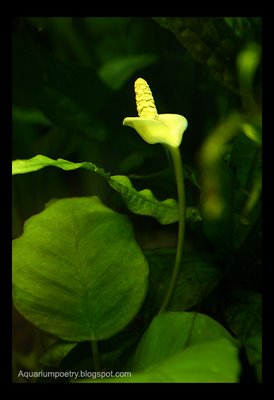Anubias barteri var. nana
 Anubias barteri var. nana is a small, attractive plant which thrives in all conditions. It grows slowly, and the leaves survive for several years, giving slow-growing algae the chance to become established. The best result is achieved by planting on a stone or tree root. Fishing line can be used to attach the plant until it gains a hold. If planted on the bottom the rhizome must not be covered because it tends to rot. It flowers frequently under water. It is not eaten by herbivorous fish.
Anubias barteri var. nana is a small, attractive plant which thrives in all conditions. It grows slowly, and the leaves survive for several years, giving slow-growing algae the chance to become established. The best result is achieved by planting on a stone or tree root. Fishing line can be used to attach the plant until it gains a hold. If planted on the bottom the rhizome must not be covered because it tends to rot. It flowers frequently under water. It is not eaten by herbivorous fish.
Height; 5-15cm Width; 8cm Light; very low-medium Temp; 20-30'C
Growth; Very slow
Demands; very easy
Text from www.tropica.com
Photos by Dusko Bojic.




